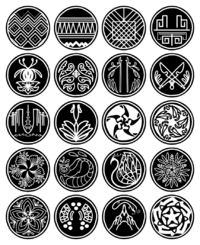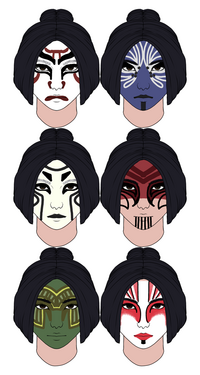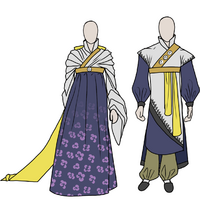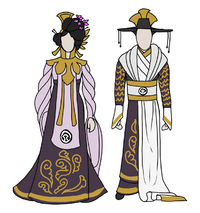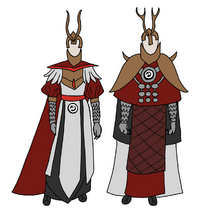More actions
| Sihai | |
|---|---|
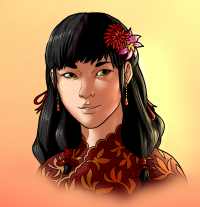 | |
| Race | |
| Pronunciation | Seehai |
| Classification | Human |
| Common Nicknames |
|
| Languages | Wai-lan |
| Naming Customs | See Language section |
| Racial Traits | |
| Distinctions | An Eastern Human race of loyal Dragon-worshipers who uphold their principles to the bitter end. |
| Maximum Age | 250 |
| Eye Colors | Varying per Kingdom |
| Hair Colors | Varying per Kingdom |
| Skin Tones | Varying per Kingdom |
To be Sihai is to know reason and calm, to uphold proper custom even when the world has gone mad, and to follow the word of the protector Loong, Dragons caught in slumber. They reward the special attention and protection the Loong give them with a rigid belief in their lessons, and wherever they go, hold to them with a stiff-backed resilience that would put the most stubborn Dwarf to shame. The Sihai adventure, trade, and lend aid to like-minded people, as staunch allies who can be counted on to keep their word at even the most difficult hour. Since the throne of their Sheng Emperor went quiet, they have begun to plot an increasingly unpredictable and open destiny for themselves, rising to the world stage for the first time in millennia and aspiring to make themselves known in far-away lands. One thing will always be certain: as long as the Dragons draw breath and the Demons can be cast from the walls, the Sihai will fight on.
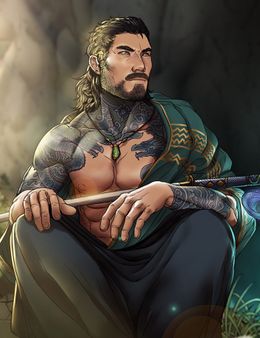
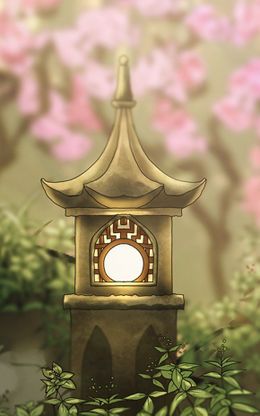
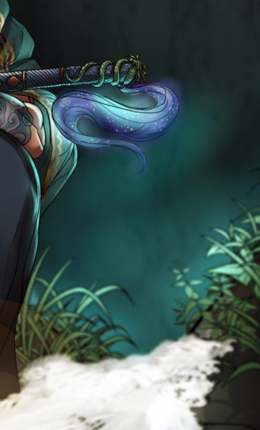
Core Identity
The Zhong Kingdoms
All playable Sihai are from the Zhong Kingdoms. While their homeland lies in the Sheng Empire, to which the Kingdoms owe nominal allegiance, communications slowly broke down before collapsing around 100 years ago. The Emperor’s black legions retreated, and the requests for tribute stopped, although the unmanned gold ships are still sent out of respect: only to be left untouched on the shore. Most Sihai understand that something has gone terribly wrong, but the Kingdoms’ governments presently still forbid sailing east to investigate, although this may change in the future. Each of the Zhong Kingdoms has its own characteristics and local sensibilities, although they are all part of the overarching Sihai culture.
Beian
The northern Beian Kingdom is set amidst frosty mountains reminiscent of Ellador, and is home to the many monasteries of the Sihai, including the Great Temples where the Loong sleep. Under its white flag are the Sihai’s finest Primal Mages, Loong Priests, and healers. Beian Sihai are lithe and limber, and hold the Dragon Beishén as their patron. They are stereotyped as calm and soothing, attuned to a meditative mountain life of simple, honest work. The other Sihai see them as more selfless. The Beian Lunar Spirit is the Crane.
Heiyan
The western Heiyan Kingdom is geographically the largest, and commands the largest population. Its climate is just as diverse, ranging from open steppe to sprawling deserts. Under its green flag are the Sihai’s main body of engineers, craftsmen, and builders. Heiyan Sihai are tall, and hold the Dragon Ao-Jin as their patron. They are stereotyped as proud and boisterous, loving the spotlight, and making sure everyone sees their skill (just as much as they love helping others shine). The other Sihai see them as ambitious glory-hounds. The Hei-Yan Lunar Spirit is the Qilin, an elegant deer with a single horn.
Jin-Lung
The eastern Jin-Lung Kingdom is calm and fertile, home to lazy river valleys and an abundant rice crop. Under its yellow flag are the famous Sihai crossbowmen, as well as many gardeners, farmers, and other workers of the land. Jin-Lung Sihai are visually diverse, and hold the Dragon Nishiliu as their patron. They are stereotyped as resourceful and dedicated, always solving problems, and always landing on their feet. The other Sihai call them ‘slippery’, not as an insult, but as praise for how quickly they find optimism. The Jin-Lung Lunar Spirit is the Peacock.
Huo-Chang
The southern Huo-Chang Kingdom is blasted and volcanic, a land which though rich in ore, yields little of value. Under its red flag march the hunters, strategists, smiths and swordsmen, the martial arm of the mostly peaceful Sihai people. Huo-Chang Sihai are broad and rough, and hold the Dragon Liu-Xing as their patron. They are stereotyped as reserved and stoic. The Huo-Chang Lunar Spirit is the Lá Wolf (IRL Tibetan Wolf), a loyal volcanic pack-hunter.
Dexai
The far western Dexai Republic sits atop a small island, the sole gate through the Jade Wall through which Westerners may enter. Under its blue flag are high artists, entertainers, merchants, and navigators, the pioneers of airships and trade-houses. Dexai was only settled heavily within the past 300 years, and so Dexai Sihai are a relatively new culture. The Dragon Xin-Shidai is their patron. They are stereotyped as gregarious people-pleasers who talk to anyone, and dress and act more western. Most Sihai in foreign lands are from Dexai. The Dexai Lunar Spirit is the Red Panda.
Dragons
The Loong, or White Sky Dragons, have dwelt among the Sihai since the beginning. They have chosen champions and emissaries from among them, lent them ancient knowledge, and encouraged them to progress and prosper at every turn. Although the Loong never demanded worship, their protection of the mortal Sihai, unique among Dragons, has earned them their undying loyalty and adoration. The Sihai can point to many times in history where the Loong have saved them from calamity, or guarded them like their own children. Thus, when the Loong send commands through the winding turns of dreams, they are quick to obey. No people is so loyal to Draconic thought as the Sihai are to the Loong, a fact only reinforced by their physical presence. Even as they slumber, their Great Temples remain open to religious pilgrims, and the works of the Dragons are all around them. This is further discussed in the Religion section.
Akula
When the Cataclysm was over in the west, massive amounts of Void Essence traveled east and started forming the Akula, massive Void infested beasts and monsters as tall as the towers of the Imperial Palace of Regalia that would rise out of the ocean and march on Dexai with the intent to destroy the Sihai lands. The Loong Dragons performed the Great Protection Ritual, which froze the seas around the Sihai lands into solid Jade, thus also creating the Jade Wall. By their final instructions before they entered their slumber, they instructed the Sihai to man the walls, and so the Sihai did. Ever since, every 5 years or so, waves of Akula besiege the Jade Wall, and the Sihai stand to defend, each Zhong Kingdom plus Dexai and the Sheng Empire sending their own specialized legions. After two hundred years, the Sheng Empire suddenly pulled back their Black Imperial Legions, and has not been heard from since, though the other Sihai nations still hold firm. The Jade Wall has not yet been broken, and Dexai still stands, however the ocean approach between the West and the Sihai lands remains dangerous, as Akula roam the area regardless of attacks on the Jade Wall. This ocean would later be called the Void Divide, stretching between Farahdeen and the East, requiring Celestial Navigators from the Sihai lands to safely cross and avoid the Akula hotspots. Combating, or sending supplies to combat the Akula is a major societal topic, even for Sihai in Regalia who routinely send supplies and aid home to help in the struggle. Equally, the Akula represent a business opportunity, as their flesh can be purified and is considered a dangerous delicacy, and their bodies produce a great deal of useful Alchemy ingredients.
Design
Mental Characteristics
Sihai culture encourages politeness, cordiality, and a sense of respect towards all people. No disagreement, to the Sihai, is so severe as to break the peace over it. There will always be another day, another perspective, and another opportunity to handle the issue. For the most part, the Sihai are peaceful and very reserved, preferring to keep the goings-on of their lives to themselves. In a reflection of how their Kingdoms have mostly closed themselves off from the world, so too are most Sihai loath to let outsiders into the realm of their personal business, and go it alone on many things where a little bit of help could go a long way. This, their sense of personal pride and self-sufficiency, is both an asset which helps them stay strong through dark times, and a common personality flaw that can make gaining their trust infuriatingly difficult. In general, the Sihai dislike verbosity and flattery, believing them to be tools for con-artists, but have an appreciation for artfully wording things, in a way which can communicate a point with special beauty or personal understanding. Sihai gentleness should not be taken as an invitation to be pushy: Sihai keep many invisible lines in the sand, and a moment of overstepping boundaries can quickly ruin a carefully built friendship.
Physical Characteristics
The Sihai take from IRL East-Asian references. It is thus possible to confuse them with Asian-coded Ailor. In body shape, they occupy the same range as Ailor, but mostly shave their facial hair off unless they are from Huo-Chang. Sihai eye colors include jade greens and different dark shades of brown, but never gray or light brown. Their hair is almost universally black or dark brown, but there is some natural auburn among Sihai from specifically Jin-Lung. Skin tones cover the same range as Ailor, from the most common fair colors to more warm olive and brown, to sometimes even as dark as the Songaskians - who the Sihai also age at the same pace as, living longer than Ailor (up to 250 years.)
Lunar Shift
The Sihai possess so-called Lunar Shifts, the ability to take on animalistic traits in symbolism to certain patron animals of the different Kingdoms. These can manifest as Transformations either partly on specific body parts (such as only the arms or only the head), or wholly as anthropomorphic humanoid. While a wider range is allowed, the main ones include the Qilin, Red-Crowned Crane, Tibetan Wolf, and Crow. Lunar Shifts do not count as disguises, even if the Sihai in question would change so much as to become physically unrecognizable. A Shifted Sihai can never be confused for an Asha or any other similar Race, even if they can sometimes resemble them.
Sihai in Regalia
Sihai in Regalia are equally extremely integrated, and extremely segregated. There are Sihai populations of merchants or their descendants who have long accustomed themselves to Regalia and essentially live like Ailor, and then there are Sihai who are fresh off the boat from the far east, and have no clue where they landed. The State expects to be able to communicate and cooperate well with new Sihai citizens, but the reality is that things in Regalia are often so alien to the Sihai that a lot is lost in translation, and problems arise. Sihai who are new to Regalia often seek out Sihai who are already familiar, which is risky, as many of the more Regalia-inclined Sihai have gotten well connected with the Regalian criminal underworld, and may not have the best intentions. While Sihai can exist without any discrimination, there is always a level of distance between the Sihai and what happens around them. They are often in the middle of events, but end up feeling like spectators behind a large window, always involved but never quite invested.
Heritage Traits
When designing a Character, Proficiency Points allow for a limited Ability selection with Point Buy Packs. Heritage Traits adds free Packs and Mechanics on top of that to help with cultural themes. Free Packs grant Abilities usually, while Mechanics change the way a character functions in Roleplay through subtle, and usually out of Combat ways. In essence, Mechanics just add aesthetic flair that invest in the niche of each culture. Free Packs never raise Proficiency Points, but the character must be able to purchase them normally. (ex. if a character is a certain Affinity that locks them out of a category, they cannot take that specific free pack and must choose the alternative option.) If a Free Pack grants Magic of some type, that Magic can be of any Alignment the character can normally choose, or limited to a select alignment, which will always be written in the Free Pack description.
Mixed Heritage characters (i.e. characters born from two parents of different Cultures) may take one parent's 'Free Packs' and mix and match up to 5 Mechanics from both parents, although some Peoples cannot produce Mixed Heritage children (due to Magical/Fantasy reasons).
Mechanics
- Sihai can telekinetically move, reshape, recolor, and restructure Jade with their mind. They can also turn any crystal-like substance or noble metal into Jade.
- Sihai can read the position of the stars anywhere telepathically, allowing them to know exactly where in the world they are at any time, even during daylight.
- Sihai can enter a trance-sleep, enveloping themselves in a hard shell of jade in a tranquil state, unable to be acted upon or to act, only freed with the touch of a friend.
- Sihai may receive calamity visions during pivotal choice moments in Staff Events (Private Message to DM to discuss opportunities) that may warn from bad decisions.
- Sihai weapons, when channeled with the powers of the Loong Dragons (out of Combat only) can cut through any material, including objects, doors, gates, but not solid walls.
Language
The Sihai speak a short-worded, tonal language called Wai-lan. Most have little accent in Common, but sometimes notes can linger. Wai-lan is based on Tang-era Middle Chinese, but modern standard (Putonghua/Mandarin) Chinese can be used for ease of translation. Some Wai-lan dialects can be represented by the pronunciation of Chinese loanwords in early Vietnamese, Korean, and Japanese, but Chinese is most accurate. Wai-lan is written in real-world Chinese characters. Writing can be either vertical, read from top to bottom with columns going from right to left, or horizontal, written left to right.
Naming Customs
Generally speaking the provincial distribution of Sihai naming and culture goes like this, despite the province names all being in Wai-lan:
- Dexai is more Overseas (Malay/Singaporean/Indonesian) Chinese inspired.
- Huo-Chang is more Japanese inspired.
- Hei-yan is more Korean inspired.
- Beian is more Northern Chinese or Tibetan inspired.
- Jin-Lung is more Southern Chinese inspired.
But, generally speaking, a Sihai can belong to any cultural inspiration and be from any province. The Wai-lan language and Sihai court culture come from many millennia of Sheng rule which has largely displaced the customs of the native people who were there before the Sheng colonists, but never quite effaced everything, including languages and names. Only Wai-lan is listed mechanically and described solely because it would be difficult to coordinate having eight different incommunicable Sihai languages, but they exist, and players are free to discuss and improvise.
Clan Names
Sihai family names usually come from the list of the dominant 100 Han Chinese family names, but can come from other applicable languages (see top of section) as well, though you should not mix and match. Unlike in other Cultures, where family is often unchangeable, Sihai are quick to merge families and adopt longtime friends as brothers. Sihai can also be expelled from families or choose to leave them if they do not see eye to eye, picking a new last name and separating.
Religion
The Sihai are almost universally followers of Draconism, believing from their point of view that they have a particularly good and special relationship with the Green Dragons under Severena. It is a matter of Sihai oral tradition that the first Sheng Emperor made a deal with the Dragons that is scarcely understood or even remembered in the modern day, but that whatever it is he promised, the Green Dragons have stuck around for the Sihai ever since and would do anything for them, seeing them as their children, and keeping the Sheng Emperor's line of descent as their head priests, or 'Matrons' from the wider Draconic point of view. Uniquely among Draconists, they also take the time to acknowledge and worship the lesser Dragons of Severena's clade, who they see as Gods in their own right. Even though they are more like siblings, each one is seen as a son of Severena, with all of them being male.
- Severena's Sihai name is Saaima. Her worship is explained on the Draconism page proper.
- The first-born is Nishiliu the Pathfinder, who is a patron of craftsmen and those who create with their hands.
- The second-born is Beishen the Allseer, who used to speak to Sihai in their dreams, and is now uniquely among Green Dragons awake and out in the world.
- The third-born is Liu-Xing the Skyfury, who is the patron of the Sihai warrior monks and soldiers in the field.
- The fourth-born is Ao-Jin the Futureteller, who is the weaver of fated thread and especially romantic relationships.
- The fifth-born is Xin-Shidai the Welcomer, who is the patron of tradesmen, journeymen, and those who give hospitality.
- The sixth-born is Ao-Shun the Princeling, who is the patron of the Sheng Monarchy and autocracy and noblemen, missing since the Emperor's silence.
- The seventh-born is Lüra the Loyalist, who is the patron of honor and duty and service, also missing since the Emperor's silence.
The Sihai also have a large, coordinated priesthood of monks. Called River Guards, they populate the temples which dot the Sihai lands, and are stereotyped as being stoic, meditative warriors. Some of them are Mundane, while others are Aegis type Archon, based on specialization. Seeing River Guards in the West is rarer than in Sihai lands, but recent years have seen their numbers abroad swell quite a bit. Squadrons have been dispatched in the past by both Temple authorities and the Dragons themselves (through dreams) to help western Dragon Worshipers find their footing and protect the religion. Even though a Western posting is seen as less prestigious by the River Guards, it is no mark of shame to serve abroad.
Families
Sihai families reside under a so-called Patrimonial Estate (or in rare cases, a Matrimonial Estate), where a single family ruler is the lord and master of the household. This is usually the oldest male person alive in the family (and in rare cases, the oldest woman), though it is also possible for an older person to forgo the position to a younger generation and retire in the final few years of their lives. Sihai family leaders have complete authority, and as such, families can sometimes live under a fairly tyrannical authority that dictates who marries who, who lives where, and what purpose children will have in life. It is unthinkable to defy the will of one’s family elder(s) and high respect and obedience to parental figures is a cultural cornerstone. Houses are usually multi generational, and cousins may often live in the same house together, but have very strict separation rules. It is fairly uncommon for example for cousins to play together, unless the parents specifically gave permission beforehand, even if they live in the same house and are merely a hallway apart from one another. In general, Sihai homes are very quiet and tranquil places: the loud noises of running around and screaming are not permitted.
Childhood
Sihai children live a disciplined life where strong expectations are dictated by parents, though that is not to say parents cannot be kind or caring to children in need. Sihai parents show some leeway for a child to adapt, but have the policy that if a child will eventually need to learn to swim by itself. Banishment of children who have failed to live up to parental expectations in teenage years are not unheard of, and without fail, most of these orphaned teenagers end up conscripted in the military or religious services. On the flip side, Sihai society does have an extremely active adoption service for children, teenagers, and even adults. Sihai Orphanages have extensive bureaucratic procedures, and a child who has lost their parents due to the Jade Wall would never be parentless for more than six months. Child services provided by the Zhong Kingdoms are also excellent, making sure that every child has a disciplined and caring parent. Adult adoption also occurs to a degree, but only when moving up in the world. For example, it is not possible for a peasant to adopt another peasant, however a noble may adopt a peasant to promote them into the world. It is even permitted for Sihai parents to adopt lower social ranks and make them their heirs, and for all intents and purposes, those adopted adult heirs are seen as full-blood relatives, including any offspring they produce. This occurs fairly commonly in noble families where the expectation of performance on the children is so severe that they often fail to meet them, resulting in their parents passing them over for more competent Sihai from the lower classes who show talents in need.
Adulthood
Sihai adulthood is primarily dictated by profession and field of service. Once someone has dedicated themselves to either a path within the bureaucracy or the military, it is very common to serve for life. This is because the power one holds within Sihai organizations is traditionally dictated by seniority, with leadership always composed of older men, and thus it is always advantageous to stay around longer where one has already committed instead of flipping around between roles. However, many ways of life leave much room for hobby work and other alternate interests, something especially visible in the great Sihai cities, where craftsman’s fairs draw people together in the most unexpected ways. It is not unusual to learn, for example, that a dour-looking soldier traditionally posted by the West Gate is also an avid writer of romantic fiction, nor any other combination of unrelated jobs and interests. While strong familial ties remain during adulthood, and regular communication with parents is expected, it is generally the case that Sihai move away from their childhood home to pursue work in their adult lives, and take up a pursuit entirely different from the one their family traditionally does.
Romance & Gender Norms
Sihai Romance is very rigid. They are strictly monogamous: adultery or even being flirtatious outside of wedlock is considered a grave betrayal, and has severe legal repercussions. Even in Dexai, a serial adulterer can be put to death for unfaithfulness, and in general, betraying or disgracing the family name is one of the greatest cultural errors one can commit. Polygamy is non-existent among the Sihai, and romantic relations usually rely on the male to make the first step and lead on the relationship while the female is expected to be passive. Same-sex relations do occur in Sihai society, and technically the Sihai are completely fine with them existing. However, because of the expectation of child-bearing for future generations, there can be an implicit homophobia in parents, because same-sex relations are often not very fruitful in producing offspring. Sihai gender norms are equally rigid. The Sihai do have masculine and feminine roles and are relatively patriarchal. Masculinity is generally seen as more 'responsible' and 'worthy' overall due to this patriarchal structure, leading to some romanticization of masculine women and women who live as men. It follows that certain roles, including the military, the priesthood, and undertaking, free the individual from gender expectations. A priest is a priest, not a woman: treated only according to station, even by the most socially conservative, because Sihai social conservatism comes primarily from obedience to station in hierarchy.
Politics
At the very top of Sihai society is the Sheng Emperor, who ruled from the Sheng Empire, the land where none may enter. Technically, the Zhong Kingdoms take all orders from the Sheng Emperor, however the Sheng Emperor has been silent for nearly a century, and as such, the second highest authority of the Zhong Kingdoms has taken over day to day instructions to the people, that being the Zhong Kings who are united in the Zhong Kings’ Council. Each Zhong Kingdom is represented by their King, while Dexai sends its President as Dexai functions more like a Republic. These all vote unanimously on changes, though as they are all inherently in favor of the Status Quo, barely any votes pass, and barely anything gets proposed. Below the Council are the Great Families, who engage in a lot more infighting than the Kings who are relatively peaceful. The Great Families often act as governors of regions or are just very wealthy magistrates or entrepreneurs, frequently with their own private army. They fight over big things like control of towns and resources, but may also fight over small things like a spilled tea cup or a finely woven silk dress. On an equivalent level to the Great Families are the Temples, which exercise their own authority from their high perches, and are not afraid of baring their teeth and sending out the warrior monks to defend themselves when challenged. Peasants who live in the authority of the Temples usually have a better life than the ones living under the governors, but there is a great deal of regional variance, because not all Great Families are obsessed with power and control, many of them wish to simply faithfully and loyally serve their King, and are seen as very competent administrators. Relations with the west are very complicated. The Sihai do acknowledge some level of need for western items. For example, Regalia produces far better telescopes and magnification glass than the Sihai do, and Regalian cartographical tools are far superior. Inversely, there is a very high demand for Sihai silks in the west, along with spices and even art. There is extremely minimal trade with the west, only allowed to pass through Dexai, and only under the strictest supervision, with every shipment being triple checked for any residual magic and the Sihai merchants frequently trying to under-provide or over-charge western merchants.
Cultural Additions
| Image | Description | |
|---|---|---|
|
Gamiun, or Miun, are the heraldic sigils of Sihai collectives, Clans, Families, or Great Families. These sigils are used on a variety of things from door-knobs, hilts of weapons, print on silks, stamped on napkin rings, engraved on cabinet doors, etc. A Gamiun is essentially a stamp of ownership on an item belonging to a specific group of people, but also a symbol of pride worn by the individual to represent their collective. Distinguished individuals (nobles, ambassadors, government officials) often also possess their own personal sigils, which they use to sign documents alongside or in the place of a written signature. These personalized sigils are often very similar to their main collective sigil, with only minor alterations. Gamiun are often stylized in a way that is supposed to figuratively represent something about the bearer or their organization, and many take great pride in what the narrow intricacies of their personal design say about them. Gamiun are used across all Sihai subcultures, with preferences ranging from organic shapes, weapons, flowers, and depictions of the Stances and Dragons, to geometric shapes and weaving patterns. | ||
|
Kiiyo or Miàn are the symbolic war paint of the Sihai. A Kiiyo is unique to each Sihai, as to the Sihai, a Kiiyo isn’t just a sign of “I am going to battle”, but rather “watch me as I die”. They are applied with the expectation that the warrior will not return from battle, and that their Kiiyo is their death mask that they will be buried or displayed with. Kiiyo change very little as a Sihai ages, and are applied shortly before battle either by friends or family or the Sihai themselves. It is a very solemn occasion, sometimes in complete silence, and sometimes with melancholic singing by the applicant while the warrior mentally prepares for battle. A Kiiyo can have many colors, and sometimes colors are chosen to reflect the descent of the Sihai from the Zhong Kingdoms, though white masks are just as common. The masks are inherently meant to invoke a sense of sadness, rage, or intimidate opponents. Kiiyo should not just be shown for fun, and never worn to public festivities unless they are specifically demanded for a cultural occasion, because while wearing one, the Sihai signifies they are ready to die, which is not a decision made lightly. They are extremely personal, and it may take quite some time for a Sihai to trust a person enough to show them such a personal aspect about themselves, as it is equivalent to showing someone one’s personal diary, or burial tomb in the West. After a victorious battle, and if still alive, the Sihai will ritually clean their face with spring water and a linen towel, after which the linen towel is burned or de-threaded and re-woven into a lantern which can be released into the night sky to symbolize letting go of their feelings. Some warriors of the Sihai have facial tattoos, but Kiiyo is used regardless. | ||
|
Sihai common clothing is simple yet refined. The waist is set high for both sexes, with the chest piece usually being white, but other pieces being of vibrant colors. Women wear a large colorful ribbon on the back of their dress that is folded twice over itself and left to hang. Men wear two smaller ribbons in the front that tuck underneath their high waist belt. For both sexes, the clothing is usually very puffy, comfortable, and covering, with high collars and barely any skin visible. Women's clothing usually has some form of flower, animal, or plant embroidery or pattern dyed into the fabric, while men's clothing may have dragon claws or scales as patterns on the fabric. A Gamiun is always visible on the waist and chest bindings, which are the ends of the fabric holding the whole ensemble together. Finally, men usually have a flap of fabric in the back that is longer than the skirt in the front, though it never touches the ground. | ||
|
Sihai wealthy clothing is often compared in opulence with Altalar clothing, and it certainly has similarities with Ithanian style also. Both men and women have wide flowing and voluminous fabrics that gently float in the wind as they move around. Women have large gold-plated decorations, usually in the shapes of leaves and lilies. They have a large flap of fabric in the front that usually has their Gamiun on it, while their long dress has patterns of clouds or waves on it. They wear a large wig which usually leans more to volume and height on one side over the other, decorated with silk flowers and golden dragon scales and hair pins. Men on the other hand have a tightly woven wool chest covering, with sleeves covered in dragon scale stitchings, and a similar but smaller dress with cloud patterns on it. Men’s sleeves are usually long (often appearing too long), so as to allow them to perform actions with their hands without revealing their fingers, or to use their sleeves as handkerchiefs to avoid touching the skin of others. | ||
|
Sihai military clothing can both be functional and ceremonial. Sihai armor is often seen as strange by the west because it makes use of a lot of symbolic shapes that most western warriors consider inconvenient in adrenaline fueled combat. This however underestimates the Sihai tactics of slow and meticulous warfare, where their heavier armor usually protects them from extended skirmish phases. Both men and women have tightly forged lamellar dragon-scale armor, and gloves with claws affixed. Women usually have decorative white feathers, while men have larger hardened leather spikes. Despite its bulky appearance, Sihai armor is actually quite light, as they favor many layers of lighter materials over single layers of steel armor. Padded leather and tightly stitched cotton are common, while the helmets always have Loong horns on them, a two pronged horn for men and a single horn for women. | ||
History
The history of the Sihai is long and old: it goes back millennia, to before the fall of the Meraic Civilization. Their original homeland, the Sheng Empire, was formed from a peaceful union of families under the Zhuyin Dynasty—guided personally by the Sihai gods, the Dragons. Though it had contact with foreigners, first the Meraic and after them the Altalar, it established quickly that the rest of the world was tainted. This had to do with the Demonic invasion that destroyed the Meraic, and the Magic the Altalar use in every part of life—the Dragon-worshiping sensibility of the Sihai leading them to see this as evil, and corruption. Centuries after first contact with the Altalar, the Sheng Sihai colonized continents west of their landmass, giving rise to the Zhong, or Middle, Kingdoms. At first just forts meant to bar the road east, these Kingdoms quickly became both heavily populated, and autonomous. They are five in number: Beian to the north, Heiyan to the west, Jin-Lung to the east, Huo-Chang to the south, and the west-most island of Dexai. Although they fought many wars between themselves, none ever ended conclusively.
There was always a distinction between the Sheng mainland and the Zhong colonies. While they were considered one Sihai people (ignoring largely the people already living there who the Sihai assimilated, their languages eventually reduced to dialects of Wai-lan), the Zhong states were always treated as somewhat lesser with their citizens "not allowed to step their feet onto the soil of the Emperor's Domain on pain of death", even as hundreds of years passed and they developed gargantuan cities and centers of learning of their own, with even most of the Dragons moving west to dwell there rather than remain in the Sheng lands. It is important to remember always that the Sihai history is as long as the history of the Allorn Empire, if not longer because they had interactions with the Meraic, a fact the Sihai are very proud of and always cite as the opening salvo against Elven nationalists in a bar argument. Just because Sihai history is not as tumultuous as Elven history, and the Sihai did not imperialize and conquer and reshape their corner of the world through imperialistic expansion, does not mean that they did not have their own famous last stands, legends, heroes and tragedies. An example being the expulsion of the Allorn Ambassadors, when the Allorn dignitaries brought their dark magics ashore in an attempt to impress the Sheng Emperor on tour in Dexai with the number of nations they had subjugated to their will, resulting in him famously rebuking them for daring impose on the Son of Heaven and ordering them ejected.
The geopolitical role of the Sihai was only shattered when the Altalar, far west, invited a Demonic invasion similar to the one that had ended the Meraic. Although the Altalar believed they had halted the Demons, the reality was that they had instead attempted to retreat into Sihai lands, and been caught by the Dragons there. The energies it took to drive them back saw the Dragons fall into slumber, although not before raising a great wall of jade to protect the Sihai people. Atop it, the white, green, yellow, red, and blue flags of the Kingdoms fought together, under the banner of the Sheng Emperor’s black legions. Although the Demons were repelled once, every few years they return, bearing towering deep-sea forms and crashing against the defenders. The Sihai have named these Akula, and continue to do battle with them to this day. Since the Cataclysm, the Sihai have enjoyed relative stability, ruled by the gentle hand of the Zhong Kings’ Council of Five. In recent years, a personally led military mission by Regalian Emperor Cedromar has caused them to warm up to Regalia. And so their people, always a scarce sight in that country, have finally begun to turn up, on the heels of goodwill and the dream-given commands of their Dragons.
World View
World View is optional content that helps give Sihai flavor and depth. When this section discusses ‘the Occult’, it is talking about non-Dragon Occult. The Sihai love Dragon Occult.
- Sihai nod as a way of acknowledging a point someone else has made. It is the preferred way of showing that one is listening without throwing in one’s own words and interrupting a point before it has been fully formed.
- The Sihai have a complicated relationship with the Occult, beyond the normal dislike expected of Dragon Worshipers. They know it exists in the west, and believe that westerners are making a mistake by coexisting with it. But at the same time, they also think the west is currently relatively stable, and so any apprehension towards the Occult is mostly replaced with curiosity. The Sihai are generally not interested in becoming Occult themselves, but love hearing about Occult people’s stories and how they justify the moral weight of their Magic use to themselves in the context of the danger it poses.
- Access to the Zhong Kingdoms is strictly forbidden for outsiders. In order to gain even a tiny bit of access, one requires a Dexai Passport, which is only given after 5 years of consecutive living in Dexai. Finally, in order to pass beyond the shipping gates of Dexai one must be Mundane or Dragon Occult. Any other Occult are quickly slain by the Jade Guardians, and anyone attempting to cross the Jade Sea on foot is quickly found by the Dragon-fly patrol craft.
- Because the Sihai lands are so hierarchy-driven, and because obedience to authority is drilled into the Sihai from a young age, adapting to Regalia's hierarchy always proves simple for the Sihai, and respect for the Emperor is easy to garner. The Sihai still fondly remember Emperor Cedromar's assistance to the most recent Akula attacks on the Jade Wall, and as such are generally pro Regalian Emperor, and in favor of good relations with the Regalian Empire, while having no trouble being loyal to Emperor Alexander I while in Regalia.
- Despite the Sihai dislike of Magic, there is a single Occult-populated slum in one of Dexai’s poorer districts. It is so dingy that it makes Crookback look like a gentrified neighborhood, but it is the one place in Sihai civilization where non-Draconic Magic is pursued, behind the boundaries which it cannot cross.
- The Sihai are not especially fond of Half Sihai, not because of any kind of visual based racism, but because Half Sihai represent a member of Sihai society who has partially been lost to the traditions of a non-Sihai power. They get along decently in foreign lands, but Half Sihai tend to have issues integrating properly should they ever wish to return east.
- The Sihai have twins and triplets more often, and call them Twin and Three Moons respectively. They believe that either they will achieve great things through cooperation, or bring disaster to their family through infighting.
- The Sihai are very literate. Millennia of academic culture has led to everything from treatises on flora and fauna to historic annals enjoying high popularity. Common fiction genres include heroic novels about monks and young heroes fighting to uphold the world, tales of enlightenment through introspection, romantic poetry, and more. It’s a mark of fluency in Wai-lan to quote old books and proverbs in everyday speech, something that would-be language learners often struggle with.
- The Sihai prefer to paint the natural world. It’s considered an ill omen for something to look upon its reflection. For that reason, most Sihai only commission one self-portrait their entire lives, which says things about them through scattered details, and do their best not to look at it.
- Sihai art is supposed to evoke the memory of a place in a viewer. It often brings an uncomfortable sense of deja vu to those who aren’t used to it. Many Sihai like to compare with each other what a particular art piece made them recall, making a game of forming judgments from comparisons.
- There is a Sihai jade-sculpture style which uses the same material as their Jadetech. It is always religiously charged, with depictions of the Loong front and center.
- The Sihai consider calligraphy a high art, and judge one another’s class and poise by handwriting quality. There are stereotypes about what a person’s brush-strokes say about them. It is common for Sihai artists abroad to make a few coins by entertaining wealthy foreigners with calligraphy of their ‘Sihai Names’, with the characters meant to reflect something in their personality.
- The Sihai enjoy a large number of rural sports, such as track races, boat races, hiking, weight-lifting, and pole-climbing. Wealthier Sihai might see these, and the tan one gets from playing them, as beneath them.
- Sihai martial arts blur the line between fighting for combat and fighting for pleasure. Many kickboxing styles don’t take themselves so seriously, and there are plenty of disciplines that are really just about staying healthy.
- There are also sword and spear-sparring styles which use light bamboo weapons, and permit full contact. They’ve achieved wide popularity as ways to train novices how to fight without potentially deadly injuries occurring during sparring.
- Every Sihai city or district has at least one fighting pit, where everyone from traveling monks to career soldiers can pitch their swords against one another. Group spars and even duels are seen as a team exercise, because spars are not real fights: always more about giving entertainment to those watching. The Sihai are perhaps the only culture that sees it this way.
- There are many different beasts in the Zhong Kingdoms, ranging from six-legged man-eating tigers to stone Anui Lions. Fantasy is the limit when it comes to the many creations of the Loong, and the Sihai landscape is home to a plethora of interesting and unusual creatures.
- Sihai cuisine is incredibly diverse. Focusing on freshness, it draws from the vast palate and spice list of the Four Kingdoms. Sihai food is commonly bite-ready: something that can be picked up and put in the mouth without extra preparation. But there are also many dishes fried in shallow-bottomed pans, soups prepared with fermented soy-paste stock, and a thousand different ways to prepare fish. The imagination is the limit.
- Sihai housing interiors are just as planned as the cities themselves. It’s considered luckiest to build floors in a series of five rooms per, and for each home to have only a single door in, and a moon-watching round glass window somewhere in the house atop a meditation mat. Sihai furniture is all very low-set, with cushions and boards instead of couches and tables. One kneels rather than sits.
- Sihai temple-architecture, built of plain wood, is designed to fade into the landscape. Surrounded by nature, it is supposed to evoke a sense of peace and isolation in a pilgrim. In contrast, the Great Temples of the Loong are awe-inspiring mountain fortresses, every pillar gilded, jade-graven maps of the cosmos spanning the roofs.
- The most prominent Sihai instrument is the seated zither, which are seen as the refined and melodic style of court ladies. There are also upright string instruments placed in the lap, played in plucked style or with a bow, and flutes, which are mournful, soft, and reedy. The string instruments carry the melody, while drums are always the backdrop. The Sihai see drums as having an aggressive, military quality: so songs which are romantic or idealistic have none, while anything ritual or in honor of the army is guaranteed to be driven by drum-beats.
- The free-thinking and inventive musicians of Dexai have organized themselves into the House of Instrumentation, a group which travels the world and Sihai-ifies foreign music into their own styles. They have a traditional friendship with Teledden musicians, with whom they compare and debate harp styles.
- The Sihai are very respectful towards the military and soldier classes, even those of foreign nations. It is not uncommon for a Sihai to verbally thank soldiers for their service, often not knowing that Regalia has soldiers that are on permanent rotation who never see combat.
- The Sihai like the Unionist figures Emperor Allestrain I, Empress Elia, Arch-Chancellor Alexander the Giant, and Duchess Leona. They have written a number of historical novels about them, many illustrated, and surprisingly often more accurate to detail than the Regalian accounts. The Sihai see these people as heroes, and use them to build a romantic image of the West, holding them up as the best Regalia has to offer.
Holidays
Some Sihai holidays are listed for observance.
- Yuhai is a festival held on January 5th, when the Sihai hold that Demons are strongest, fueled by the solar eclipse. It is celebrated with elaborate ritualistic dance patterns led by Loong Priests around a multi-colored bonfire, and invoking prayer to the Dragons, that their dreams will not end and the world will persist.
- Mia-hang is a festival held from March 13th to 17th where the Sihai celebrate themselves and their own culture by being very visible and loud about it, going out of their way to refer to literary classics, appreciate music, and give everyone around them an earful about what makes their village unique.
- Faihan is a festival held on April 8th that celebrates the life and health of the Loong. Sihai households take care of their Loong altars on this day, and leave offerings before them.
- Ra-hae is a festival held on June 11th that focuses on contributing to local charity and sheltering those in need. On this day, Sihai indulge in hospitality, offering drinks and kindness to strangers and hearing their stories.
- Cente is a festival held from September 22nd to 25th that celebrates the purity and simplicity of creation, during which Sihai wear purely white robes and tend to don stylized, unpainted wooden masks that say something about them.
- Players are free to make up more themselves.
Trivia
- The Sihai have vehicles that travel across the petrified Jade Sea beyond the Jade Wall, but an often less discussed topic is Sihai airships. They do in fact have airships powered by Jadetech and other Primal Magics, and these airships put Regalian airships to shame with their enormous colossus-size length, though they move extremely slowly.
- Most Sihai houses have a decorative Jade guardian at the front door, even in Regalia. Though, for the houses in Regalia, Sihai are not permitted extensive weaponry in inside their homes, so these guardian statues are often no bigger than an adult’s forearm, and have very limited mobility.
- A Cearden Ailor businessman has taken the Sihai name of Liliao (a birth-name, curiously), and begun an aggressive marketing campaign for a brand of vanilla ice cream in the outer Dexai islands which has met with stunning success.
| ||||||||||||||||||||||||||
| Accreditation | |||||||||
|---|---|---|---|---|---|---|---|---|---|
|
| ||||||||
